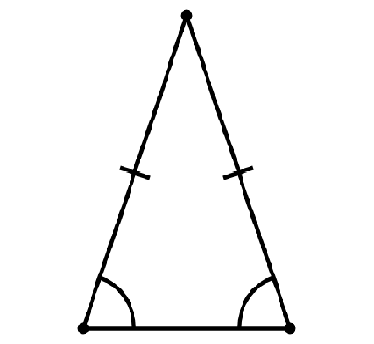
Answer
433.2k+ views
Hint: Triangle types are defined by angle and length properties. It is possible to calculate the missing angles of a triangle easily if you know what type it is. The sum of angles in any triangle is ${180^\circ}$. On a diagram, equal sides of a triangle have one small line or dash drawn on each side.
Complete step-by-step solution:
Definition: (Isosceles triangle)
An isosceles triangle is a triangle that has two sides of equal length.
Sometimes it is specified as having exactly two sides of equal length, and sometimes as having at least two sides of equal length, the latter version thus including the equilateral triangle as a special case.
The two equal sides are called the legs and the third side is called the base of the triangle.
The other dimensions of the triangle such as its height, area, and perimeter can be calculated by simple formulas from the lengths of the legs and base.
What is Acute angle?
An acute angle is less than${90^ \circ }$
How many acute angles can an isosceles triangle have?
All isosceles triangles have two acute angles. Because the sum of the interior angles of a triangle must be ${180^ \circ }$ .Acute angle is less than $90$ degrees. Any two angles of a triangle must have a sum of less than $180$ degrees.
We require two equal angles for any isosceles triangle. The sum of these two must be less than $180$ degrees so any one of these two angles must be less than $90$ degrees, meaning “acute”
Diagram:

Note: Every isosceles triangle has an axis of symmetry along the perpendicular bisector of its base.
The two angles opposite the legs are equal and are always acute, so the classification of triangle as acute, right or obtuse depends only on the angle between its two legs.
Area of isosceles triangle $ = \dfrac{b}{2}\sqrt {{a^2} - \dfrac{{{b^2}}}{4}} $
Perimeter of isosceles triangle $ = 2a + b$
Complete step-by-step solution:
Definition: (Isosceles triangle)
An isosceles triangle is a triangle that has two sides of equal length.
Sometimes it is specified as having exactly two sides of equal length, and sometimes as having at least two sides of equal length, the latter version thus including the equilateral triangle as a special case.
The two equal sides are called the legs and the third side is called the base of the triangle.
The other dimensions of the triangle such as its height, area, and perimeter can be calculated by simple formulas from the lengths of the legs and base.
What is Acute angle?
An acute angle is less than${90^ \circ }$
How many acute angles can an isosceles triangle have?
All isosceles triangles have two acute angles. Because the sum of the interior angles of a triangle must be ${180^ \circ }$ .Acute angle is less than $90$ degrees. Any two angles of a triangle must have a sum of less than $180$ degrees.
We require two equal angles for any isosceles triangle. The sum of these two must be less than $180$ degrees so any one of these two angles must be less than $90$ degrees, meaning “acute”
Diagram:

Note: Every isosceles triangle has an axis of symmetry along the perpendicular bisector of its base.
The two angles opposite the legs are equal and are always acute, so the classification of triangle as acute, right or obtuse depends only on the angle between its two legs.
Area of isosceles triangle $ = \dfrac{b}{2}\sqrt {{a^2} - \dfrac{{{b^2}}}{4}} $
Perimeter of isosceles triangle $ = 2a + b$
Recently Updated Pages
10 Examples of Evaporation in Daily Life with Explanations

10 Examples of Diffusion in Everyday Life

1 g of dry green algae absorb 47 times 10 3 moles of class 11 chemistry CBSE

If the coordinates of the points A B and C be 443 23 class 10 maths JEE_Main

If the mean of the set of numbers x1x2xn is bar x then class 10 maths JEE_Main

What is the meaning of celestial class 10 social science CBSE

Trending doubts
Fill the blanks with the suitable prepositions 1 The class 9 english CBSE

Which are the Top 10 Largest Countries of the World?

How do you graph the function fx 4x class 9 maths CBSE

Who was the leader of the Bolshevik Party A Leon Trotsky class 9 social science CBSE

The Equation xxx + 2 is Satisfied when x is Equal to Class 10 Maths

Differentiate between homogeneous and heterogeneous class 12 chemistry CBSE

Difference between Prokaryotic cell and Eukaryotic class 11 biology CBSE

Which is the largest saltwater lake in India A Chilika class 8 social science CBSE

Ghatikas during the period of Satavahanas were aHospitals class 6 social science CBSE




